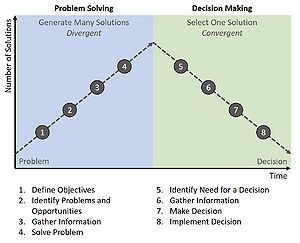SPALTEN
Improving Decision Making in Project Management with the SPALTEN Problem-Solving Methodology
Author: Felix Dressel
This page is under construction
This article describes the approach of the problem-solving methodology SPALTEN in a Project Management context.
The SPALTEN problem-solving process was initially published in 2002 by Albers et al. as a method which is universally applicable to any sort of problem in product development and project management.[1] SPALTEN can be adapted in condition and complexity to any problem. Its strength is to gather and analyze the given situation as well as to create, rate and select possible solutions. The method also enables the user to divide one big problem into smaller ones. Consequently, it is easier to manage the problem and work out a solution.[2] It is confirmed, that due to its flexibility, engineers are able to apply SPALTEN throughout the entire product development process as well as across multiple other activities in project management.[3]
The term SPALTEN was designed as an acronym representing its different steps (in German). The method is structured by seven working steps, each of which can be carried out with different subordinate methods.[4] The seven steps are:
(S) Situation Analysis
(P) Problem Containment
(A) Alternative Solutions
(L) Selection of Solutions
(T) Consequences Analysis
(E) Make Decision and Realization
(N) Recapitulate and Learn
The following chapters of this article will elaborate how the SPALTEN problem-solving process is implemented, how the different steps are carried out in practice (course of action, examples, etc.) and what its limitations are. Additionally, other influencing factors like the problem-solving team, a regular check of information and a continuous idea storage will be introduced together with their relevance and application in this method. Depending on the length of the topics mentioned before, also a gamified approach (The SPALTEN Expedition) can be presented.
Contents |
Overview
Problem Solving and Decision Making in Project Management

In the process of project management, the successful realization of the projects often depends on the ability to solve problems when encountered. As Burke and Barron state: “A project is often just a big problem that needs to be solved.”[5] While such a problem might often be seen as an obstacle, it also provides an opportunity through which the current situation can be improved. To address the problems the project manager needs a problem-solving system to identify the problem as concrete as possible but also needs to come up with creative solutions.[5]
The processes of the identification of problems and the decision making of different solution possibilities are often connected. While the problem-solving process focuses on concretely defining the problem and coming up with different solutions (divergent), the decision-making process has to consider all the different solution possibilities by taking into account the surrounding situation and has to ensure that the selected solution solves the problem as comprehensive as possible (convergent). These two sides are visualized in Figure 1.[5]
The SPALTEN Problem-Solving Methodology
How to use SPALTEN
Situation Analysis
Problem Containment
Alternative Solutions
Selection of Solutions
Consequences Analysis
Make Decision and Realization
Recapitulate and Learn
Improving Decision Making with the SPALTEN Problem-Solving Methodology
The Limitations of SPALTEN
References
- ↑ Albers, A., M. Saak, N. Burkhardt, and D. Schweinberger (Eds.). 2002. Gezielte Problemlösung bei der Produktentwicklung mit Hilfe der SPALTEN-Methode
- ↑ Albers, Albert, Nicolas Reiß, Nicola Bursac, and Jan Breitschuh (Eds.). 2016. 15 Years of SPALTEN Problem Solving Methodology in Product Development
- ↑ Saak, Marcus. 2006. Development of a concept and of a prototype for a computer-aided tool for the efficient employment of the problem solving methodology "SPALTEN"
- ↑ Albers, Albert, Nicolas Reiß, Nicola Bursac, and Jan Breitschuh (Eds.). 2016. 15 Years of SPALTEN Problem Solving Methodology in Product Development
- ↑ 5.0 5.1 5.2 5.3 ) Burke, Rory, and Steve Barron. 2014. Problem Solving. In Project Management Leadership: Building Creative Teams, Second Edition, Eds. Rory Burke, and Steve Barron, 317–336Hoboken, NJ, USA: John Wiley & Sons, Ltd.